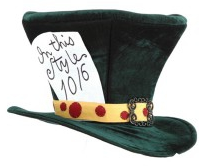
Stockport bus station, Stockport, Greater Manchester, England and in the mid-distance is St Mary’s church and to the right is the Hat Museum
I spent last week in Istanbul, Turkey and Stockport, England helping institutions in Europe expand their online class offerings. While in Stockport, our host arranged for a tour of the Hat Museum. Stockport was the center of hat making for several hundred years and almost all hats made and sold from England had their origins in Stockport. Even the American classic Stetson was invented in Stockport.
As we were taking the tour, our guide explained the process of using mercury in a boiling vat to shrink the felt as the first part of the production process. Workers who were exposed to the noxious vapors emitted from this process often exhibited odd and aggressive behaviors and were described as being mad as a hatter. The toxic effects of mercury poisoning were discovered in 1829 and 35 years later, Lewis Carroll injected the Mad Hatter character in his classic tale, Alice in Wonderland. It wasn’t until 1941 that the demands for mercury in the war efforts forced the manufactures to agree to replace mercury with hydrogen peroxide in the production of hats.
Why would the hat industry continue to subject the employees to such a toxic environment when they knew the devastating effects? Maybe it was easier just to continue to do it the way they always did it.
“Yeah, it may not be good but this is how I learned to make hats and this is the way we are going to make hats.”
Maybe the companies didn’t want to invest in new manufacturing equipment and retrain their employees. Maybe the employees would lose their jobs if they were replaced with technology and the companies.
Regardless of the reason, I am sure you are trying to figure out what this has to do with education or innovation, two things about which I am passionate. Well, we know some of the things we do now in higher education are not as effective as they once were; yet we continue to do them.
We claim to be scholars but yet ignore research on what learning styles are the most effective. We still allow faculty to be the sage on stage, lecturing to classes of students despite the compelling research indicating the brain activity of students during a lecture is similar to brain activity while watching TV.
Research shows students learn as well online as in they do in the classroom and that the most effective style is a hybrid class that blends online with an in-seat component. Just like hatters were hired for their skill at making hats, faculty members are hired for their subject matter expertise. Unlike the hat factory owners, who knew better but continued to poison their workforce, as administrators, we must be embrace what we know about learning and change our practices so that our graduates don’t end up mad as a hatter!
What practices are still in use at your institution that are making you, mad as a hatter? Share with me.




